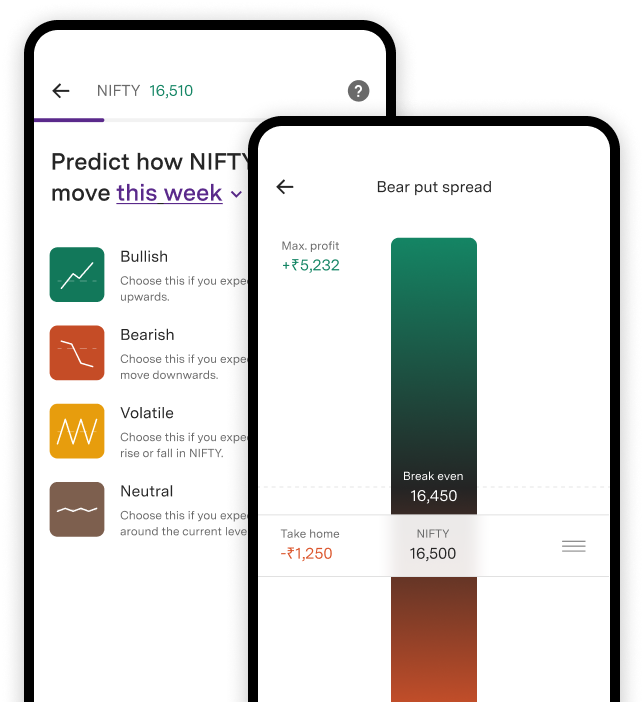Ready-made Option Strategies
The safer way to trade in options
-

Pre-curated strategies in NIFTY & BANK NIFTY
-

Higher profit probability with limited risk
-

Useful in all market trends
-

Free to use and easy execution
Key Features
Pre-curated strategies
Get low and high risk pre-curated option strategies based on your market prediction.
Helpful insights
To know your profit probability, maximum profit and loss, and funds required.
Interactive pay-off graph
Know ‘take-home’ amounts at different levels and plan a timely exit from your strategies.
Combined tracking
Strategy orders are grouped as one, to easily track profits or losses of the entire strategy.
Want to know more?
Have more questions about Ready-made Option Strategies?
Which strategies are available under the ‘Pick strategy’ flow?
There are a total of 7 strategies used in this tool. Here they are: Bullish strategies: Bull Call Spread And Long Call, Bearish strategies: Bear Put Spread And Long Put, Volatile strategies: Long Straddle, Neutral strategies: Iron Condor And Short Straddle.
What does ‘Low risk vs High risk strategies’ mean in Ready-made Options Strategies?
The strategies used in the tool are separated on their risk levels. As per this – Bull Call Spread, Bear Put Spread, Long Straddle, Iron Condor are classified as low risk as the downside is limited. And Long Call, Long Put, Short Straddle are high risk based on the unhedged nature or high downside risk. The combinations displayed for each strategy is filtered based on the probability of profit, moneyness and liquidity. About 3 to 5 pairs are shown to select from for an affordable and profitable trade.
Why are positions grouped together?
When a strategy order is traded, a strategy position is created under the ‘Positions’ tab under ‘Strategies’. The way a strategy is grouped under ‘Orders’ you can see them being grouped and shown under ‘Positions’ as well. This helps you track the P&L for individual positions as well for the entire strategy together.
Note: If you place an order twice for the same strategy, with the same strike price combination, it will be shown as 2 separate positions and it won’t be clubbed together and shown.
How can I use the P&L chart?
The P&L chart will give insight on how much will be made or lost on the strategy if the spot price of Nifty or Bank Nifty moves at a certain price. It is a best measurement tool for analysing the risk-reward ratio before entering or exiting a strategy position.
Which strategy is best for options trading?
There are nearly 500 different options strategies in India. Participants should opt for the one with which they are comfortable, understand the work and match with their risk-return profile. Investing without understanding is not a prudent investment strategy.
How do you determine the option strategy?
It depends on its suitability to the investor. It is also essential to determine market conditions, the future movement trajectory, and the options available for investing in the underlying and then take a calculated decision. Traders can use the options strategy calculator and options strategy chart to get started with options trading.
Which are the four basic options strategies?
There are two types of options strategies, put and call, and both can be bought or sold, making them the four basic techniques in the market. Investors need to play among these four.
To find out more:
What are options strategies?
Options trading strategies are popular among equity market investors primarily because of their ability to hedge risks. The common phrase used for the plan is limited risk, unlimited profit potential. In addition to the put and call choices, there is a plethora of options strategy, amounting to about 500 in all, that can be utilised.
However, most of them either are unaware of these strategies or do not understand them. Individuals need to understand these instruments thoroughly before using them to optimise their investments while reducing associated losses. In this article, we will try and analyse some of the significant strategies users should know to benefit from the investment avenue.
Different types of strategies for trading in options
Options can be traded in four different ways: call, put, spread, and straddle. Let's begin with the call and put first. A call is a contract that grants the investor the right to purchase stock on or before the option's expiration date at a particular price. The right to sell a stock at a certain price on or before the option's expiration date is offered by a put option under the terms of a contract.
Risk management techniques include straddles and spreads. Purchasing the same type of option with the same expiration date but a different strike price results in a spread. The underlying stock price at the time the option is placed is the strike price. When you purchase an option with a lower strike price and an option with a higher strike price with the same expiration date, you are creating a straddle.
The profit or loss that the trader experiences when selling or exercising the option is represented by the gap between the underlying security's current spot price and strike price.
In addition, there are a few terms that you need to know to know about the different options strategies:
The profit or loss that the trader experiences when selling or exercising the option is represented by the gap between the underlying security's current spot price and strike price.
In the Money (ITM) Options
- If the strike price of a call option is less than the security's current spot price, it is considered to be in ITM. Here, Spot- Strike > 0
- A put option is deemed to be in-the-money (ITM) if the strike price is higher than the security's current spot price. That is, Spot- Strike< 0
At The Money (ATM)
- If the strike price of a call or put option is the same as the security's current spot price, the option is said to be in ATM. E.g., Spot- Strike = 0
Out of Money (OTM)
- If the strike price of a call option is higher than the security's current spot price, it is considered to be OTM. That is, Spot- Strike < 0
- If the strike price of a put option is lower than the security's current spot price, it is said to be OTM. Therefore, Spot- Strike > 0
Here is a list of most successful options strategies that traders can incorporate. However, the best options strategy will depend on your risk profile.
Bull call spread
The bull call spread is a bullish trading technique that requires buying at-the-money (ATM) call and selling out-of-the-money (OTM) call option. This tactic is usually used when the outlook on the stock is moderate as the underlying sentiment based on fundamentals, technical and quantitative perspective isn't strong or aggressive. This is a limited profit / limited loss technique and helps reduce the premium cost of a naked option.
Bull put spread
This approach is similar to the bull call spread, a two-leg tactic that requires participants to buy an OTM put and sell an in-the-money (ITM) put option. This plan is usually used when markets have dipped, are volatile, there is time to expiry, and when views are bullish on the market going ahead. Similar to the bull put spread, this is a limited profit / limited loss strategy that helps reduce the premium cost of a naked option.
Call ratio back spread
This is one of the simplistic options strategies that provides investors with an opportunity to gain unlimited profits if the market goes up, limited profits if the market goes down, and a known loss in case the market ranges in a small band. For this, participants need to have a three-leg strategy, buying two OTM calls and one ITM call option. An increase in volatility favours this tactic in case there is time for the expiry, while limited time to expiry does not bode well for it.
Bear call ladder
While the name has a bear in the name, it does not relate to bearish markets or strategy. Instead, it is a modified version of the call ratio back spread option. The bear call is used when an investor is completely bullish on the underlying stock or index. Similar to the call ratio back spread, the bear call ladder also works on a three-leg strategy that involves buying 1 ITM call, 1 ATM and 1 OTM option.
Synthetic long & arbitrage
Synthetic long & arbitrage is a broad strategy that establishes a long and short position on the underlying stock/index expiring in the same series. Participants can profit as the futures move higher versus the breakeven point and make a loss when the future falls below that point. This linearity means that the future is also termed as a linear instrument. The tactic involves buying ATM call and put belonging to the same underlying instrument and series.
Bear put spread
The bear put spread is similar to the bull call spread and is simple and easy to implement. Investors use this strategy when the outlook on the market / underlying instrument is moderately bearish. This tactic gives limited upside in terms of profit when the underlying instrument price falls while limiting the losses in case prices go up. It requires buying ITM put and selling the OTM put option. The strategy enables limited profit or limit loss.
Bear call spread
When a trader expects the underlying stock price or index to drop, they use a bear call spread, also known as a bear call credit spread. Purchasing call at a particular strike price results in a bear call spread. In addition, although at a lower strike price, the investor sells the same quantity of calls with the same expiration date. In this way, the participant may make the highest profit with this method that matches the credit received when the deal was first initiated. People with low-risk tolerance and are content with modest earnings should use this technique.
The long straddle
The long straddle is a simple and neutral technique that is not impacted by the direction of the market movement. Profits are generated as long as there is a huge movement in the underlying security price. For this, participants need to buy a call and put with the same underlying security and strike price. The long straddle can generate unlimited profit while limiting the loss.
The short straddle
When using the short straddle options strategy, you need to sell call and put options with the identical strike price and expiration date. This tactic is market neutral. The short straddle can be advantageous when you think the underlying stock or index won't move noticeably higher or lower throughout the contracts. This shows that the investor is betting that the market will remain stable and in a trading range. Traders should ideally use a short straddle around significant events, similar to a long straddle.
Long and short strangle
The strangle is similar to the straddles except that in the strangle, investors buy OTM call and put options, unlike in straddles where they buy ATM call and put. The long strangle involves buying an OTM put and OTM call, while the short strangle requires participants to sell put and call OTM. The long strangle benefits from price movement in either direction, while the short strangle benefits from range-bound price movements. In the case of a long strangle, the profit is unlimited while loss is limited to the premium amount, while in a short strangle, the loss is unlimited while profit is capped to the total premium received.
Max pain and PCR
The max pain tactic is relatively new, less than two decades old. It tries to identify the price point of the contract that would cause the least amount of loss (pain) to the options writers and cause the maximum amount of loss (pain) to the buyers. The put-call ratio (PCR), on the other hand, is a simple ratio that allows the strategist to identify the bearishness or bullishness of the market. The PC ratio is a simple indicator to determine market direction and base your plan on it. The PC ratio can be computed by dividing the total open interest of puts by the total open interest of the calls.
Iron condor
The iron condor requires buying two puts (one long and one short), two calls (one long and one short), and four strikes. All of these should point to the same strike price of the underlying instrument. The tactic is non-directional, with the ability to generate maximum profits while restricting the losses and risk. The maximum profit is generated when the underlying asset closes in between the corridor of middle strike price expiration.
Pros and Cons of Options Strategies
Choosing an options strategy for beginners can be challenging and fraught with possible downsides and upsides. You can select which scheme is most suitable for your investment style by weighing the benefits and drawbacks of all option strategies available option methods.
Pros:
- Reduced costs of investing
- Traders can use stock options to reduce an investment portfolio's overall risk or an overall investment approach.
Cons:
- If you do not research your options, you expose yourself to high risks and may incur losses
- Traders can exercise the contracts on the expiration date.
- While you can trade with any amount, any amount above Rs.2 lakhs is considered reasonable.
As seen above, multiple possibilities are available for investors to benefit from the market. By using options, investors can generate high returns with low risk in a cost-efficient manner. That said, there are disadvantages, including liquidity constraints among some instruments, non-availability of options among all instruments, high commissions and the time decay of these options based on time spent. Participants need to look at the right strategy for them basis their understanding and risk-return profile.







